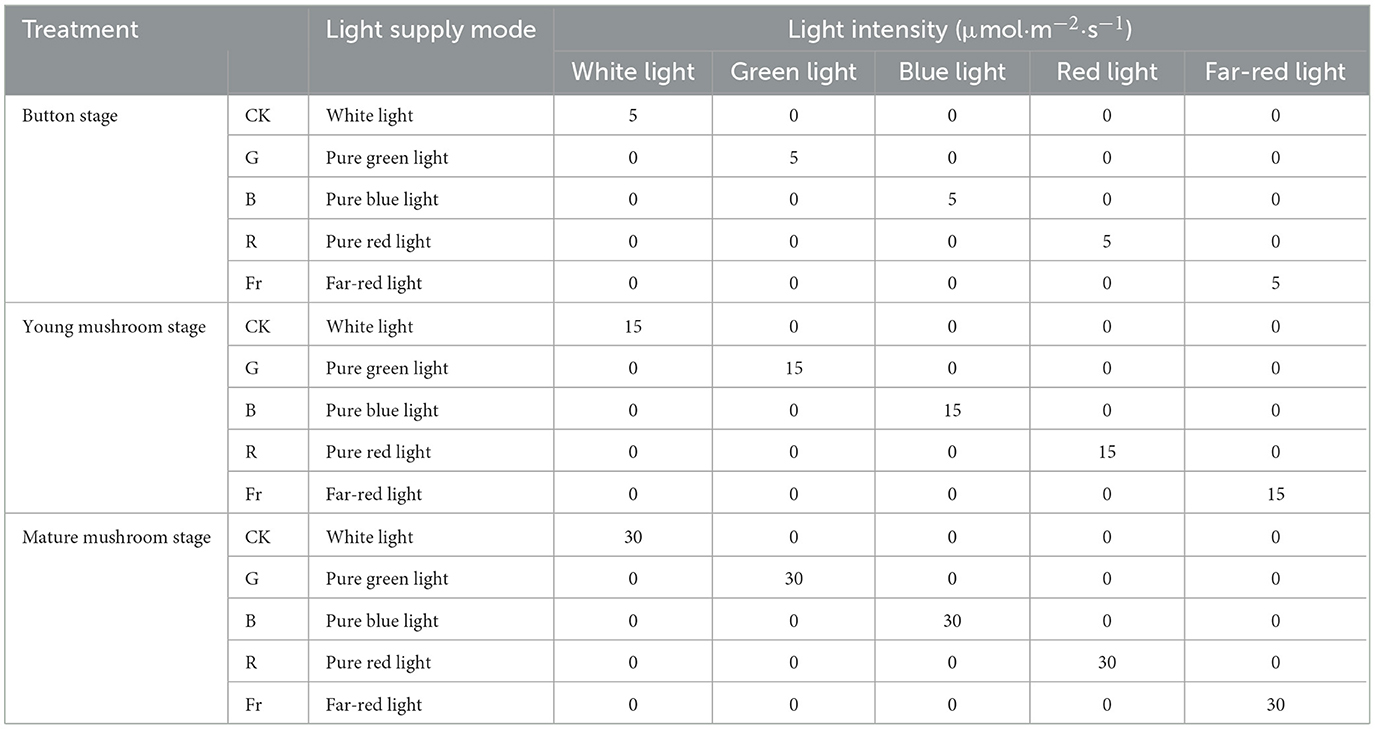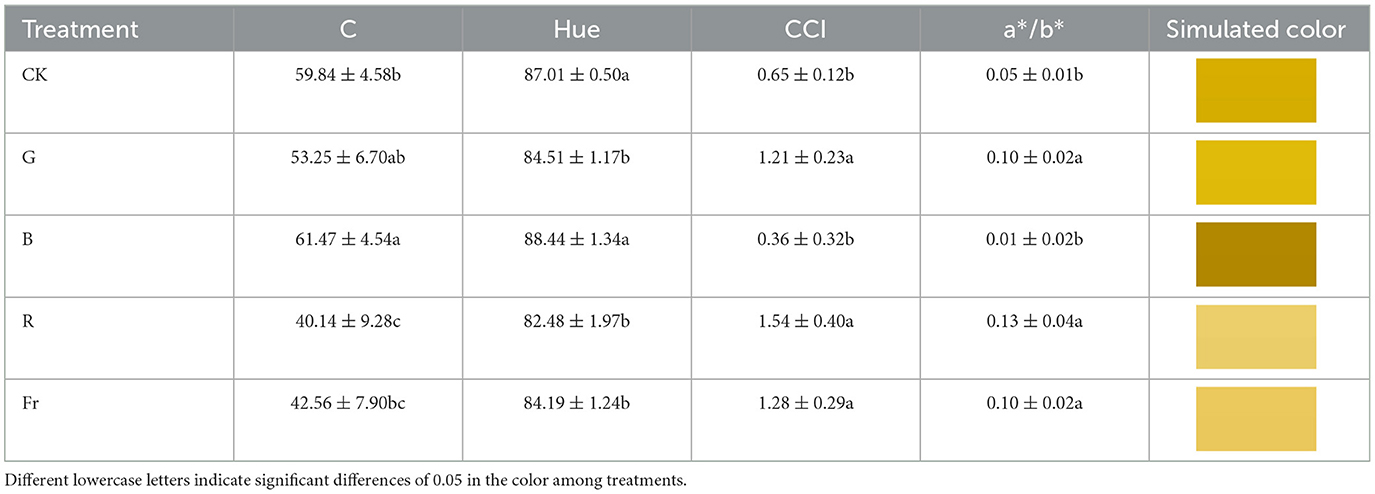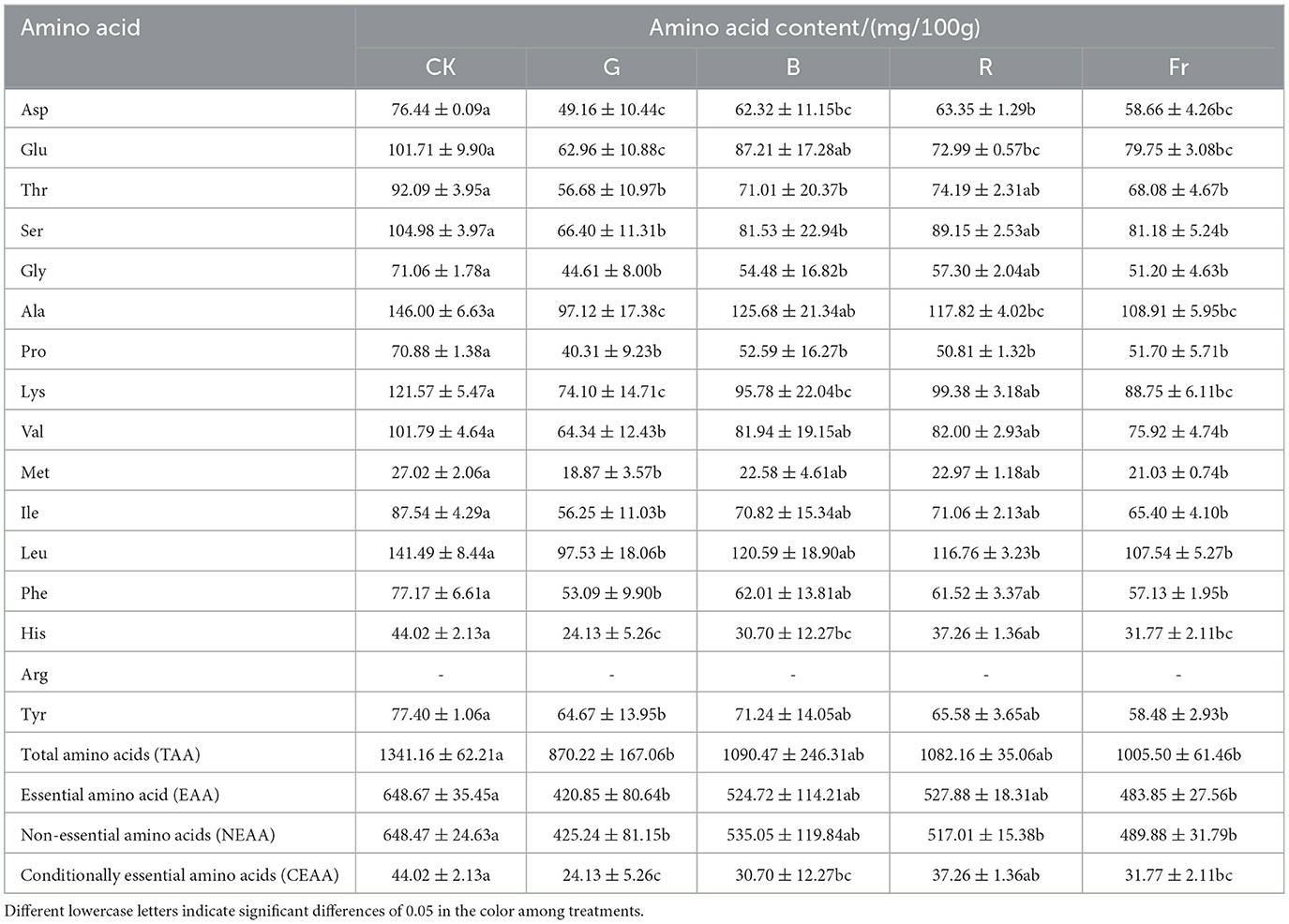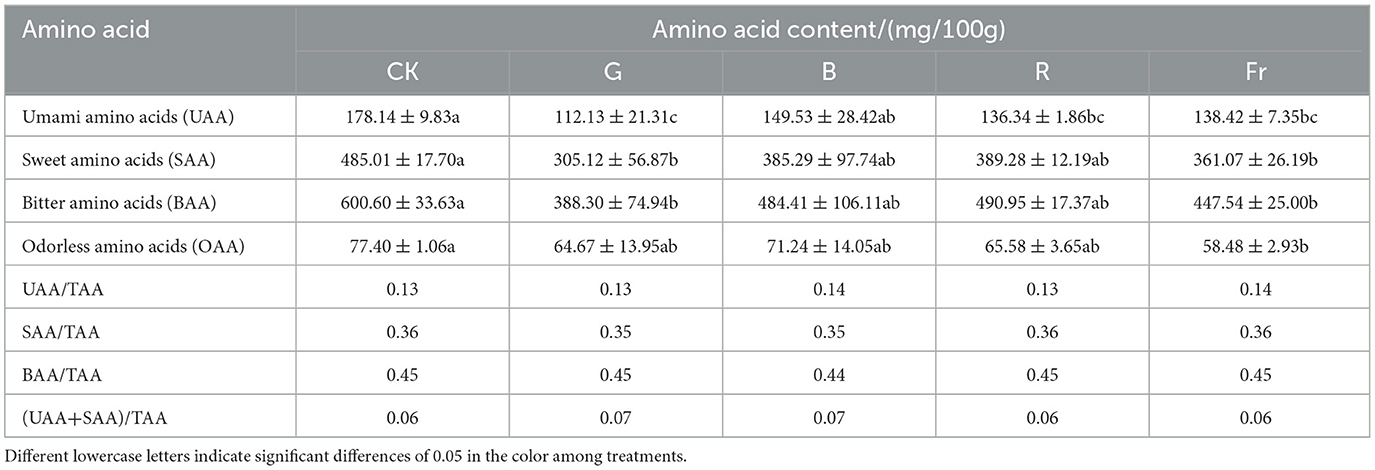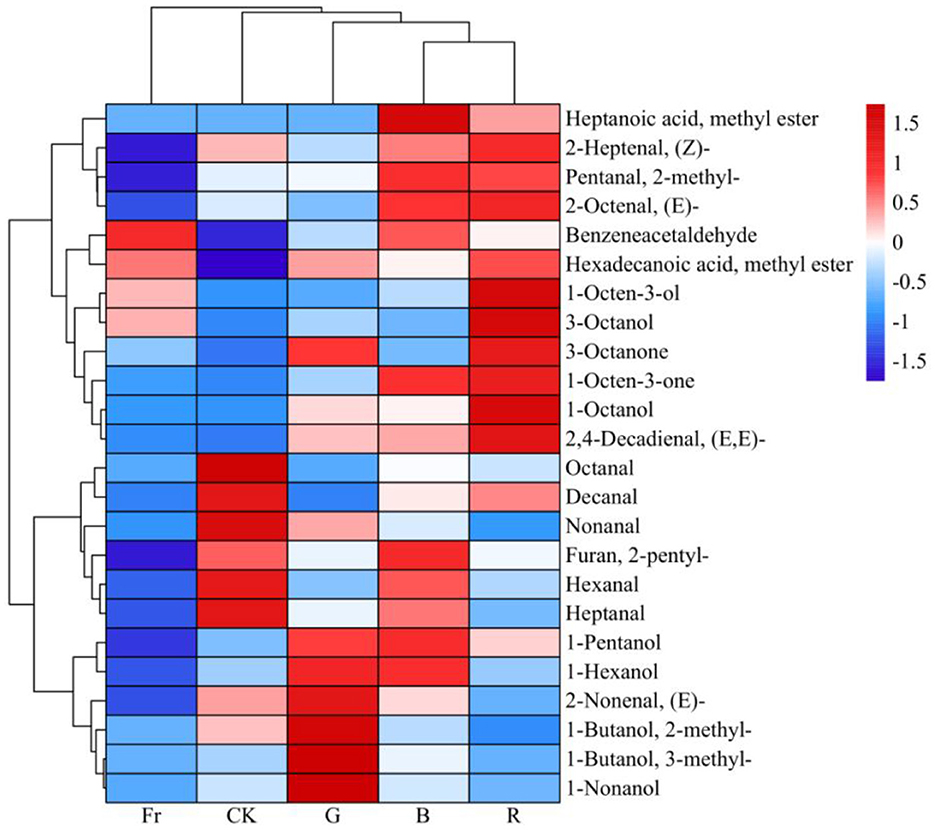- 1Intelligent Equipment Research Center, Beijing Academy of Agriculture and Forestry Sciences, Beijing, China
- 2College of Horticultural and Landscape Architecture, Tianjin Agricultural University, Tianjin, China
Light is one of the key factors affecting the flavor of edible fungi. Pleurotus citrinopileatus were planted in a growth chamber in order to investigate the effects of different LED lights on the growth and development. Five treatments were set up in the experiment, namely white light (CK, as control), pure green light (G), pure blue light (B), pure red light (R) and far-red light (Fr). The results showed that: (1) R or Fr treatment caused deformities in Pleurotus citrinopileatus, showing a soft stipe, thin pileus, and shallow color. Compared with the control, the stipe length of Pleurotus citrinopileatus significantly decreased by 12.52% under treatment B, while the stipe diameter, pileus diameter, and fruiting body weight significantly increased by 35.52%, 18.30%, and 23.66%, respectively (P < 0.05). The color of Pleurotus citrinopileatus was more plump under B treatment, among which the spectral color parameters C and Hue increased by 2.72% and 1.64%, respectively. (2) B increased the proportion of umami and sweet amino acids [(UAA+SAA)/TAA] while decreased that of bitter amino acids in total amino acids (BAA/TAA) in Pleurotus citrinopileatus relative to the control. In addition, except for B treatment, other treatments (G, R, Fr) significantly reduced the content of mushroom flavored amino acids (e.g., Asp and Glu). (3) B increased the odor activity value (OAV) of key aroma compounds in Pleurotus citrinopileatus compared with the other light qualities in this study, while R increased the OAV of 1-octen-3-ol and 1-octen-3-one. However, considering that mushrooms cannot grow normally under R treatment, this study recommended blue light as the main light quality for industrial production of Pleurotus citrinopileatus.
1 Introduction
Pleurotus citrinopileatus, also known as golden top pleurotus, is a precious edible and medicinal fungus belonging to the family Pleurotus and genus Pleurotus. Pleurotus citrinopileatus is widely distributed in northeastern and southwestern regions of China (1). The fruiting body of Pleurotus citrinopileatus is yellow funnel-shaped, hence it is called the “flower of fungi”. Pleurotus citrinopileatus has extremely high nutritional value, rich in nutrients such as protein, polysaccharides, minerals, and essential amino acids for the human body. It also has various medicinal values such as antioxidant, blood pressure lowering, and cholesterol lowering (2). In recent years, it has been widely cultivated due to delicious taste and rich nutrition.
Flavor compounds are the main active components that contribute to the flavor of edible fungi, and are also important indicators for evaluating the taste and aroma of edible mushrooms. Free amino acids, also known as non protein amino acids, mainly affect the taste of edible mushrooms. At present, 15 types of free amino acids were studied in edible fungi, each with its unique taste, such as sour, sweet, bitter, and umami, and their content directly affects the freshness of mushrooms. Yamaguchi et al. (3) found that aspartic acid (Asp) and glutamic acid (Glu) were the major contributing components of mushroom umami taste. Other studies reported that the content of Asp and Glu in different mushrooms might vary between 0.05 and 45.85 mg/g (4, 5). Volatile substances such as alcohols, esters, ketones, aldehydes, alkanes and alkenes are the major contributing components of mushroom olfactory flavor. Alcohols, especially octacarbon alcohols, are characteristic substances commonly found in edible fungi. Studies have shown that the aroma of fresh mushrooms were mainly attributed to mushroom flavored substances such as 1-octen-3-ol, 3-octanol, 1-octanol, 1-octen-3-one, and 3-octanone (6–8). Ketones endow edible fungi with floral and fruity aromas, and the fragrance is long-lasting. Aldehydes have fruity and floral flavors and are key components of mushroom flavor compounds. Esters including ethyl hexanoate, ethyl octanoate and hexyl acetate give a very pleasant taste and greatly affect consumers' choices. Some mushrooms exhibit pleasant sweetness and mushroom flavor, while others exhibit bitterness and sourness due to these substances (9–12).
Light plays an important role in the synthesis and metabolism of flavor compounds which decide the flavor of green plants (13–15). For example, Colquhoun et al. (16) reported that red light increased the content of 3-methyl-1-butanal and 2-methyl-butanal in tomato fruits. Fan et al. (14) studied the effects of different spectra and daylight integrals on the volatile compounds of Micro Tom tomatoes, finding that high daylight integrals of green light and low daylight integrals of red light would reduce the content of volatile compounds in tomato fruits. Liu et al. (17) reported that white light was more conducive to the accumulation of flavor compounds such as total furan compounds, 2,6-dimethylpyrazine, and dibutyl sulfide in sweet melon compared with monochromatic light or the darkness. In addition to green plants, photo-sensitivity also exists in non-photosynthetic edible fungi. However, since edible fungi don't undergo photosynthesis, their light responses are different from those of green plants. Edible fungi regulate physiological responses in the body by sensing light signals through photoreceptors (18). Xsu et al. (19) found that pulsed ultraviolet light (PUV) could increase the vitamin D content in Pleurotus citrinopileatus. Hu et al. (20) found that light with a wavelength of 720 nm could increase the ergosterol content in Pleurotus citrinopileatus. Ye et al. (21) studied the effects of different light qualities on the hyphae and primordia differentiation of Pleurotus ostreatus, finding that more hyphae were formed and primordia differentiation was faster under blue light irradiation compared with red light irradiation or the darkess. Du et al.'s (22) study also has shown that blue light promoted the enlargement of mushroom pileus and pigment accumulation in shiitake mushrooms. Feng et al. (23, 24) found that blue light could enhance the aroma of dried Suillus granulosus compared to red, green, yellow, and white light. In addition, Yao et al. (25) reported that ultraviolet light could increase the content of tannin, total phenols, total flavonoids, and β–glucan as well as antioxidant properties in dried L. edodes. Wen et al. (26) studied the effects of different pulsed light on the volatile compounds of harvested shiitake mushrooms and found that pulsed light irradiation increased the content of 1-octen-3-ol, 1-octen-3-one, 3-octanol, and umami amino acids in shiitake mushrooms. Rathore et al. (27) found that UV-B irradiation could increase the content of amino acids, especially Glu, in dried Calocybe indica. It can be seen that light has a significant impact on the morphology, taste, and flavor of edible mushrooms.
Compared with traditional light sources, Light emitting diodes (LEDs) has become an important supplementary light source for facility edible mushroom production due to its unique advantages such as high photoelectric conversion, low thermal radiation, and adjustable light quality. At present, most reports on the light effects of mushrooms are based on dried mushrooms after harvesting, while there is relatively little study based on the growing mushrooms. In addition, there has been no study about the light effects on the growth and nutritional components of Pleurotus citrinopileatus. Therefore, this study evaluated the free amino acids and volatile substances of fresh Pleurotus citrinopileatus exposed to different LED light irradiation to screen the optimal light environment for Pleurotus citrinopileatus cultivation. This article aimed to provide a theoretical basis for light quality regulation in the industrial production of Pleurotus citrinopileatus.
2 Materials and methods
2.1 Experimental design
The study was conducted in a growth chamber at Beijing Academy of Agricultural and Forestry Sciences. An LED light system that could set any light formula was used as the experimental light. The Pleurotus citrinopileatus mushroom bags were treated with different light qualities from the day when the mycelium was full. Five treatments were set up in the experiment, namely white light (CK, as control), pure green light (G), pure blue light (B), pure red light (R) and far-red light (Fr), with a light/dark (L/D) period of 12 h/12 h for each treatment. The wavelength peak of green ligh, blue light, red light and far-red light were, respectively, 530 nm, 450 nm, 660 nm, and 735 nm. Each treatment had 25 Pleurotus citrinopileatus mushroom bags. The growth cycle of the mushrooms were divided into three stages that were button stage (rice shaped mushroom buds), young mushroom stage (round pileus) and mature mushroom stage (funnel-shaped pileus). The light intensity for each stage was 5 μmol·m−2·s−1, 15 μmol·m−2·s−1 and 30 μmol·m−2·s−1, respectively. The wavelength peak of green light, blue light, red light and far-red light were 520 nm, 450 nm, 660 nm, and 735 nm, respectively. The light intensity and spectrum were all measured approximately 10 cm below the light source using a spectrometer (LI-180, LI-COR, USA) (Table 1). The temperature, the CO2 concentration and the relative humidity of air in the growth chamber were 26 ± 1°C, 500 μmol·mol−1 and (90±1)%, respectively, during the entire growth period of Pleurotus citrinopileatus. Purified water was automatically sprayed twice a day at 8 am and 8 pm, for 1 min each time.
2.2 Sampling and phenotypic measurement
The stipe length, stipe diameter and pileus diameter of Pleurotus citrinopileatus were measured with a vernier caliper at the young mushroom stage and mature mushroom stage. The weight of Pleurotus citrinopileatus was measured by an electronic balance at mature mushroom stage. Eight fruiting bodies randomly taken from per treatment was regarded as a repetition, and there were three repetitions in each treatment.
2.3 Color parameter determination
The color parameters of Pleurotus citrinopileatus pileus were measured using a spectrophotometer (YS3010, Shenzhen San' enshi Technology Co., Ltd., Guangzhou, China). The spectral data was processed to obtain the color saturation (C), hue angle (Hue), color index (CCI) and color ratio (a*/b*). The larger the C, the higher the color saturation of the pileus. The Hue reflected the coloring of the pileus. CCI could be used to evaluate changes in the color of pileus. a*/b* was the comprehensive color index. The calculation formula was as follows:
2.4 Free amino acids determination
The content of free amino acids was determined referring the method proposed by Boogers et al. (28). 0.5 g mushroom sample mixed with 20 mL pure water was extracted for 10 min in boiling water, and then diluted to 50 mL. Then, free amino acids standard solution, borate buffer, and derivatizing agent were added into a derivatization tube (6 mm × 50 mm) for derivatization. The mixture was placed at room temperature for 1 min, and then detected in an automatic amino acid analyzer (LA8080).
2.5 Volatile substance determination
2.5.1 Sample extraction
Samples were extracted by solid-phase microextraction technology (SPME). 3.0 g mushroom freeze-dried sample and 2-methyl-3-heptanone (internal standard substance) were mixed in a 15 mL headspace bottle. Extraction head that had been aged at 250°C for 2 h was extracted at 35°C, and then desorpted at 250°C in the headspace bottle.
2.5.2 GC-MS analysis
HP-5MS capillary column (30 m × 0.25 mm × 0.25 μm) was used for chromatographic separation, and Shimadzu GC-MS QP2010 gas chromatography-mass spectrometer was used for determination. Chromatographic conditions: the inlet temperature was 28°C, the carrier gas was helium (99.999%) with a flow rate of 3.0 mL/min, and the split ratio was 8:1. Temperature gradient program: the initial temperature of column during testing was maintain at 40°C for 1 min, the initial temperature increased to 160°C at 3°C /min, and increased to 230°C at 15°C /min, and held for 1 minute. Mass spectrometry conditions: EI ionization source, ionization voltage −70eV, ion source temperature 230°C, quadrupole temperature 150°C, solvent delay time 2 min. The data collection mode was full scan mode: 50–550 m/z.
2.6 Statistical analysis
SPSS Statistics 22 software was used for data processing and variance analysis, Origin 2021 and Hiplot software were used for plotting, and SIMCA 14.1 software was used for orthogonal partial least squares discrimination analysis (OPLS-DA). The data was represented as the mean ± standard deviation (SD).
3 Results
3.1 Phenotypic trait analysis of pleurotus citrinopileatus under different light quality
As shown in Figure 1, photomorphogenic analysis revealed distinct phenotypic responses in Pleurotus citrinopileatus to specific light wavelengths. Compared with the white light (CK), the longer stipe and larger pileus of Pleurotus citrinopileatus fruiting body at all stages were found under green light irradiation. Mushroom fruiting bodies were the shortest and most compact under blue light treatment. The mushrooms exposed to red or far-red light grew normally during the button stage and young mushroom stage, but showed deformities at the mature mushroom stage, manifesting loose fruiting bodies, soft stipe, thin pileus, and light color.
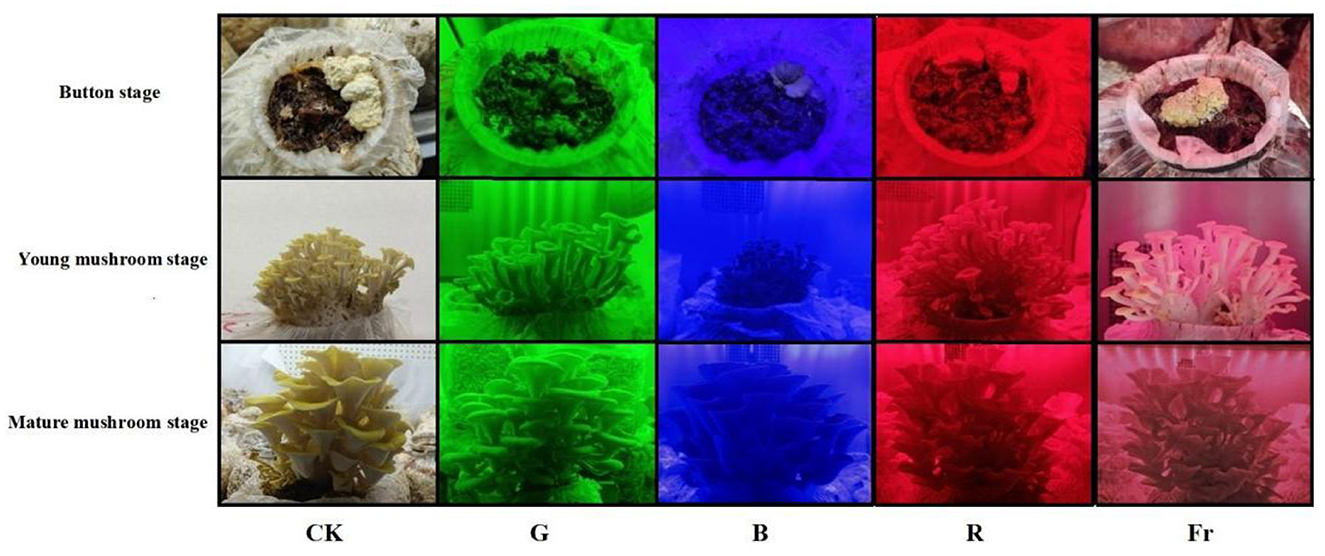
Figure 1. Photos of Pleurotus citrinopileatus at different growth stages under different light treatments.
As shown in Figure 2, compared with the control, the stipe length of Pleurotus citrinopileatus exposed to G treatment was significantly increased by 4.68%, while that exposed to B treatment was decreased by 12.52% (P < 0.05) (Figure 2a). The stipe diameter of mushroom exposed to G and B treatments were significantly increased by 14.11% and 35.52%, respectively (Figure 2b). The pileus diameter under these two treatments were significantly increased by 4.86% and 18.30%, respectively (P < 0.05) (Figure 2c). As shown in Figure 2d, the weight of fruiting bodies exposed to B treatment was significantly increased by 23.66% relative to the control (P < 0.05), while that under other treatments was decreased by 0.10%-4.45%.
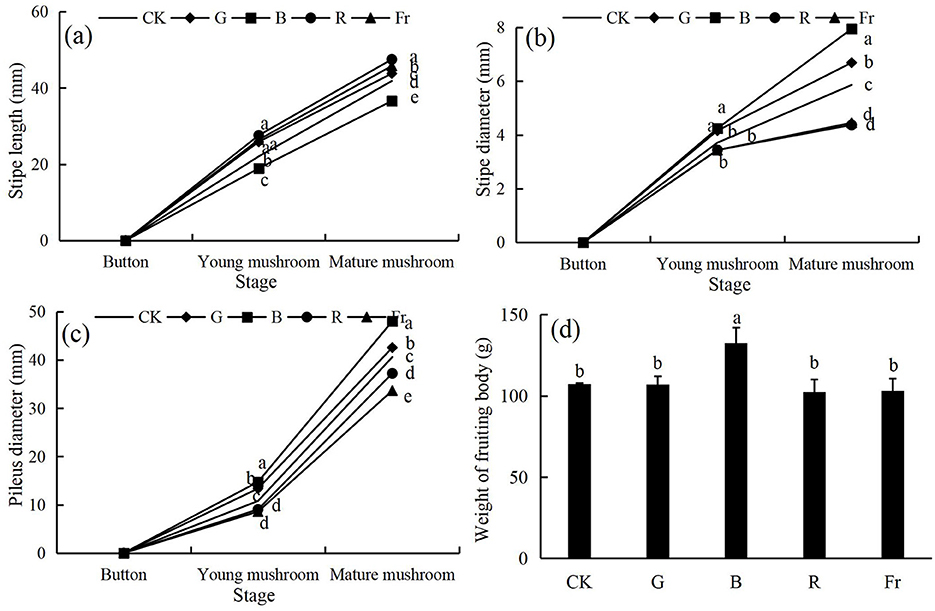
Figure 2. The stipe length (a), stipe diameter (b), pileus diameter (c) and the weight (d) of Pleurotus citrinopileatus under different light treatments. Different lowercase letters indicate significant differences between groups (P < 0.05).
3.2 Color spectral parameter of pleurotus citrinopileatus under different light quality
Considering that the color of Pleurotus citrinopileatus was mainly presented by the pileus, this study analyzed the color of the pileus of Pleurotus citrinopileatus. The C and Hue values of Pleurotus citrinopileatus pileus exposed to B treatment increased by 2.72% and 1.64% respectively, while the CCI and a*/b* values decreased by 44.62% and 80.00% respectively, compared with the control. Meanwhile, the darkest simulated color of Pleurotus citrinopileatus was observed under the B treatment. On the contrary, the simulated color was lighter under R and Fr treatments, further indicating that monochromatic red light or far-red light was not conducive to the development of Pleurotus citrinopileatus (Table 2). The color difference of pileus might be due to the different light qualities perceived by mushroom photoreceptors, leading to different transcriptional reactions within cells (29), which indirectly affected the expression of pigment related genes or enzyme activities.
3.3 Free amino acids analysis of Pleurotus citrinopileatus under different light quality
As shown in Table 3, 15 free amino acids out of the 16 amino acids detected were identified in Pleurotus citrinopileatus subjected to all light treatments. Among which, the content of alanine (Ala) and leucine (Leu) was the highest (close to 97.12–146 mg/100 g), while that of methionine (Met) was the lowest (18.87–27.02 mg/100 g). However, arginine (Arg) was not identified in Pleurotus citrinopileatus irrespective of different light treatments.
Among the 15 amino acids identified, threonine (Thr), lysine (Lys), valine (Val), methionine (Met), isoleucine (Ile), leucine (Leu), and phenylalanine (Phe) are essential amino acids (EAA), while asparticacid (Asp), glutamicacid (Glu), serine (Ser), glycine (Gly), alanine (Ala), proline (Pro), and tyrosine (Tyr) are non-essential amino acids (NEAA), moreover histidine (His) is conditionally essential amino acid (CEAA). As shown in Table 3, Figure 3, the contents of total amino acid (TAA), as well as EAA, NEAA and CEAA in Pleurotus citrinopileatus exposed to all the treatments were obviously reduced compared to the control, by respectively 18.69%−35.11%, 14.13%−22.88%, 21.20%−52.50% and 38.56%−82.43%. Li et al. (30) reported that Asp and Glu could produce a mushroom flavor. It could be seen in Table 3, except for B treatment, the other light treatments significantly reduced the content of Asp and Glu compared with the control.
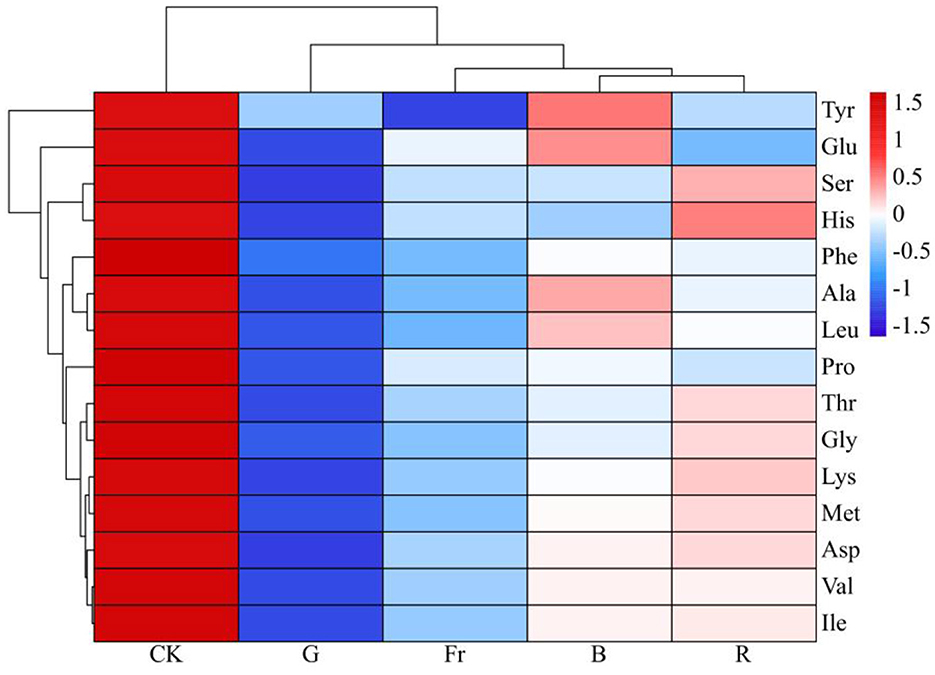
Figure 3. Clustering and heatmap illustration of synthesis of different amino acids under varied LED light treatments.
The 15 free amino acids identified in the current study included 2 umami amino acids (Asp, Glu), 5 sweet amino acids (Thr, Ser, Gly, Ala, Pro), 7 bitter amino acids (Lys, Val, Met, Ile, Leu, Phe, His), and 1 odorless amino acid (Tyr). As shown in Table 4, although all treatments reduced the content of the flavor amino acids in relative to the control, the proportion of umami and sweet amino acids in the total amino acids [(UAA+SAA)/TAA] was increased while that of bitter amino acids in total amino acids (BAA/TAA) was decreased in mushrooms subjected to B treatment compared with the control, indicating that blue light was more conducive to the synthesis of taste friendly amino acids.
3.4 Volatile substances analysis of Pleurotus citrinopileatus under different light quality
3.4.1 Qualitative and quantitative analysis of volatile substances
In terms of the number of volatile substances, totally 69 volatile substances were detected in Pleurotus citrinopileatus, including 18 aldehydes, 6 ketones, 24 alcohols, 9 esters, 9 hydrocarbons, and 3 other volatile substances (Table 5), All the light treatments enhanced the number of total volatile substances in comparision to the control, among which, the highest number was detected under R treatment, which was increased by 12.50%. The number of common volatile substances in each treatment was 35 (accounting for 50.72% of total volatile substances), while the specific volatile substances under CK, G, B, R, and Fr treatments were 1, 1, 2, 3, and 3, respectively (Figure 4a).
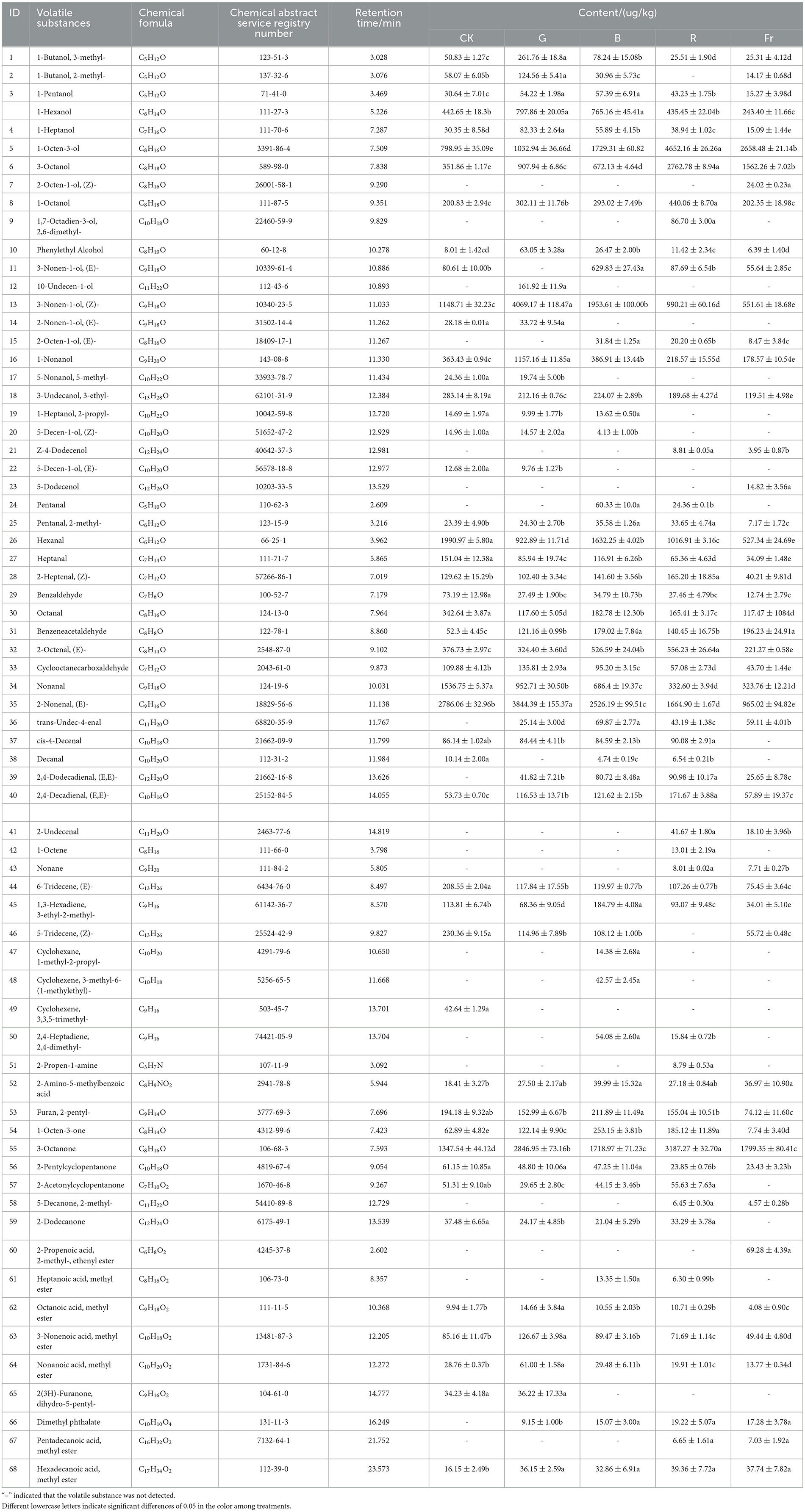
Table 5. Components and contents of volatile substances in Pleurotus citrinopileatus under different LED light treatments.
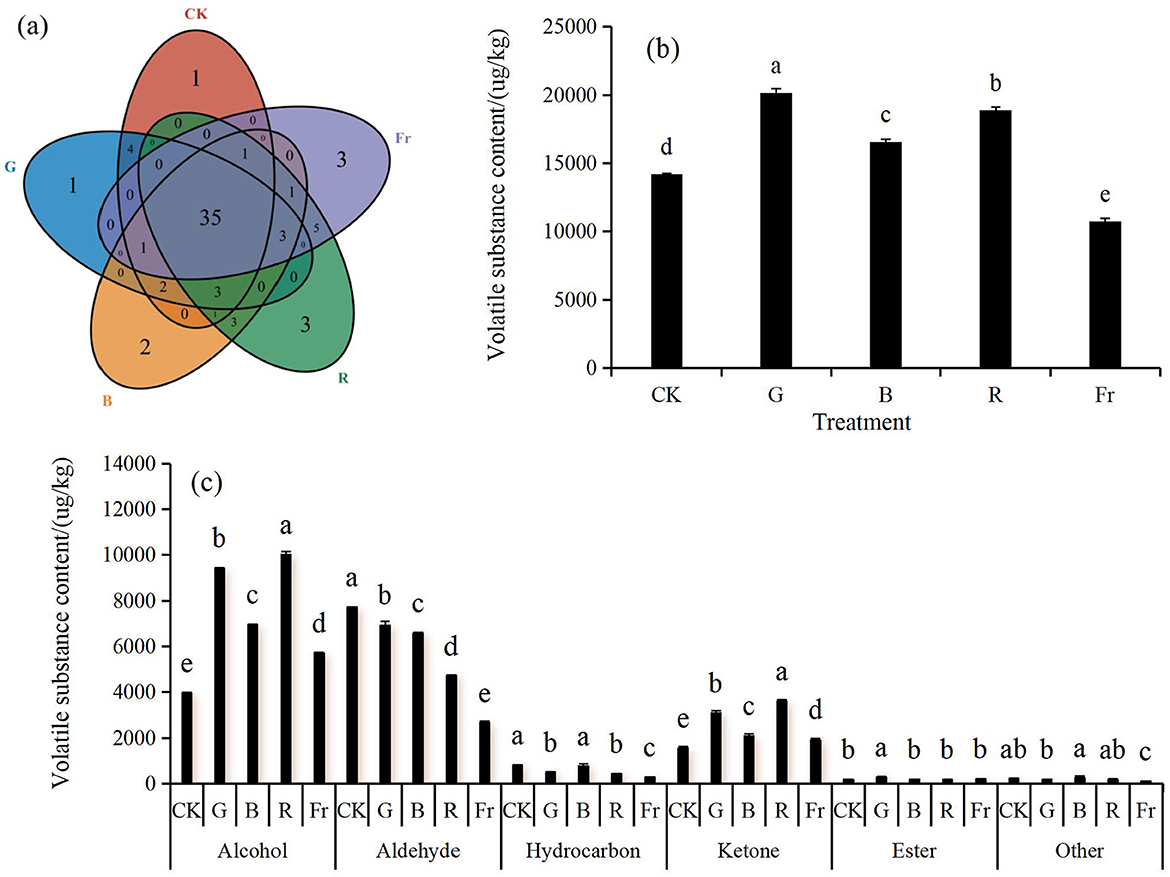
Figure 4. The number of types (a), the content of total volatile substances (b) and the content of various types of volatile substances (c) under different LED light treatments. Different lowercase letters indicate significant differences between groups (P < 0.05).
In terms of the content of total volatile substance, G, B, and R treatments significantly increased the total volatile substance content by 42.03%, 16.71%, and 33.01% compared to the control, while that under Fr treatment significantly decreased by 24.44% (P < 0.05) (Figure 4b). As regards of a certain type of volatile substance, monochromatic light irradiation (G, B, R, or Fr) significantly increased the content of alcohols and ketones by 44.54%−138.78% and 22.03%−130.18% (P < 0.05) compared to the control, among which, the highest contents were both detected under R treatment. On the contrary, monochromatic light irradiation decreased the content of aldehydes and hydrocarbons by 10.30%−65.69% and 3.98%−64.85%, respectively. This might indicate that monochromatic light was more conducive to the synthesis of alcohols and ketones, but not for the synthesis of aldehydes and hydrocarbons (Figure 4c).
3.4.2 OAV analysis of key volatile substances
Twenty four key volatile substances of Pleurotus citrinipileatus were detected in the present study, including 8 alcohols, 11 aldehydes, 2 ketones, 2 esters, and 1 other (Figure 5). Alcohols especially octanols were characteristic substances commonly existed in edible fungi. Three octanols with OAV >1 were detected in the present study, among which, 1-octen-3-ol was closely related to the “mushroom aroma”. As shown in Figure 5, the highest OAV value of 1-octen-3-ol was detected in Pleurotus citrinipileatus exposed to R treatment. Low odor threshold of aldehydes resulted in a strong odor of mushrooms. 11 aldehydes were detected in this study, among which, 2-nonenal, (E)- in Pleurotus citrinipileatus subjected to G treatment presented the highest OAV value, resulting in a sweet aroma. Ketones endowed edible fungi with floral and fruity aromas, and the fragrance was long-lasting. Two key ketones that were 1-octen-3-one and 3-octanone were detected in Pleurotus citrinipileatus under all the treatments, both of which presented the highest OAV value under R treatment. Esters could contribute to the pleasant fruit aroma of Pleurotus citrinipileatus. The highest OAV value of heptanoic acid, methyl ester was detected in Pleurotus citrinipileatus exposed to B treatment. In addition, the highest OAV values of 1-pentanol, furan, and 2-pentyl- were all detected under B treatment (31).
3.5 OPLS-DA analysis
OPLS-DA analysis was conducted with 15 free amino acids and 69 volatile substances as dependent variables and different light treatments as independent variables. The fitting index of the independent variable (), the dependent variable (), and the model prediction index (Q2) in this analysis were 0.978, 0.997, and 0.991, respectively. As shown in Figure 6a, the data points within the group were concentrated, while the data points among groups were scattered, indicating that the experimental methods and instruments were reliable and stable, and there were significant differences among groups. Therefore, the content of free amino acids and volatile substances could be used for sensitivity analysis of Pleurotus citrinipileatus to different light qualities. 200 permutation tests showed that the intersection point between the Q2 regression line and the vertical axis was < 0, indicating that the model did not have overfitting and the model validation was effective (Figure 6b).

Figure 6. OPLS-DA (a) and cross-validation model (b) of free amino acids and volatile substances in Pleurotus citrinopileatus.
4 Discussion
Light is one of the most important environmental signals that affect the growth of edible fungi, regulating their growth and physiological processes through photoreceptors.
Our experimental observations revealed distinct photomorphogenic abnormalities in Pleurotus citrinopileatus under red and far-red irradiance, characterized by three key phenotypic alterations: soft stipe, thin pileus, and attenuated carotenoid deposition. It has been shown that the synthesis of membrane transporters which sensed external stimuli and maintained biological activity in edible fungal was ineffective under red or far-red light irradiation (21). This might explain the phenomenon of deformities in Pleurotus citrinopileatus exposed to R or Fr treatments in the current study. The growth of Pleurotus citrinopileatus under R and Fr treatments appeared normal in the early stage (button stage and young mushroom stage), which might be due to the accumulated membrane transporters during the hyphal stage. However, with the irradiation of red or far-red light during the fruiting body stage, the synthesis of membrane transporters were inhibited until insufficient to maintain the normal growth of Pleurotus citrinopileatus.
Blue light irradiation made significant morphometric alterations in Pleurotus citrinopileatus, manifesting as a 12.52% reduction in stipe length, contrasted by 35.52% and 18.30% increases in stipe diameter and pileus diameter, respectively, compared with the control (P < 0.05). At the same time, B treatment significant increased the weight of fruiting bodies by 23.66% compared to the control (P < 0.05). These were similar with Jang et al.'s (32) and Kamada et al.'s (33) findings that the pileus diameter of Agaricus bisporus and Coprinopsis cinerea were larger under blue light irradiation compared with green or red light. It might be due to that the blue light receptors (WC-1 and WC-2) mainly related to the development of the fruiting bodies presented the highest level under blue light irradiation (34). Besides, it was reported that the activity of extracellular enzymes such as cellulase, peroxidase, and laccase was up-regulated by blue light in relative to red light or white light, thus accelerating the decomposition of the cultivation materials which provided nutrients for fruiting body development (18, 35). This might also accounted for the best growth of Pleurotus citrinopileatus exposed to B treatment in the present study.
The color of mushroom reflects its freshness and affects consumers' willingness (36). Our study found that the color of pileus was more vibrant under B treatment, with higher. color spectral parameters of C and Hue. Zhang et al. (37) has reported that the color of edible fungi was controlled by pigments such as carotenoids which was related to the blue light signaling pathway and was synergistically regulated by blue light photoreceptors This might partially explain the findings that Pleurotus citrinopileatus displayed well color under B treatment in this study. It implied that blue light was beneficial for Pleurotus citrinopileatus cultivation from the perspective of coloring.
Free amino acids and volatile substances are the main substances that determine the taste and aroma of Pleurotus citrinopileatus. In the current study, blue light irradiation increased the proportion of umami and sweet amino acids in total amino acids (UAA+SAA)/TAA, while decreased that of bitter amino acids in total amino acids (BAA/TAA) in Pleurotus citrinopileatus. This might be due to that blue light irradiation tended to induce the conversion of carbohydrates into umami and sweet amino acids, rather than bitter amino acids (38).
Volatile substances such as aldehydes, ketones, and alcohols were converted from flavor precursors through histidine metabolism, glutathione metabolism, and unsaturated fatty acid metabolism under the action of a series of flavor synthases. Edible fungi sensed different light qualities through photoreceptors, which affected the synthesis of precursors and the activity of synthases, thereby affecting the content of volatile substances. It has been shown that monochromatic light enhanced the synthesis of substances such as carotenoids, fatty acids, phenylalanine and branched chain amino acids, which played vital roles during the synthesis of volatile substance (39). Similar results were observed in the present study, in which, the number and content of total volatile substances were increased by G, B, and R treatments compared with the control. It was reported that blue light irradiation increased enzyme activity in edible fungi. Therefore, this study found that B increased the OAV of key aroma compounds might be due to the increased activity of synthetic enzymes by blue light, greatly increasing the content of these substances and making them characteristic flavor compounds. Feng et al. (24) also reported that most aroma compounds in dried Suillus granulatus displayed higher OAV value under blue light than other light qualities such as green, red, yellow or white light. It implied that blue light was beneficial for the mushroom flavor. In addition, the current study showed that Pleurotus citrinopileatus displayed higher OAV value of 1-octen-3-ol under R treatment than B, while the opposite results were detected in the study of Feng et al. (24). The inconsistence may be attributed to the genotypic difference between the two mushroom species or the physiology metabolic differences between pre-harvest and post-harvest mushrooms.
Blue light was the recommended light quality in this study due to the best overall performance in terms of growth, coloring, taste and aroma. However, it was worth mentioning that although mushrooms could not grow normally under R, R increased the OAV values of certain key ketones (e.g., 1-octen-3-one and 3-octanone) in Pleurotus citrinipileatus, giving them a strong mushroom flavor. Thus, it may be possible to try applying red light during the post-harvest stage of Pleurotus citrinipileatus.
5 Conclusion
Monochromatic red light or far-red light caused abnormal appearance in Pleurotus citrinopileatus, showing soft stipe, thin pileus and shallow color, while monochromatic blue light was proved to be beneficial for the growth and coloring of Pleurotus citrinopileatus. Compared with the control, the stipe diameter, pileus diameter, and fruiting body weight significantly increased by 35.52%, 18.30%, and 23.66%, respectively (P < 0.05). The color of Pleurotus citrinopileatus was more plump under blue light treatment, among which the spectral color parameters C and Hue increased by 2.72% and 1.64%, respectively. Moreover, blue light irradiation increased the proportion of umami and sweet amino acids while decreased that of bitter amino acids in total amino acids, as well as increased the odor activity value (OAV) of key aroma compounds, thereby making mushrooms present better taste and aroma.
Data availability statement
The original contributions presented in the study are included in the article/supplementary material, further inquiries can be directed to the corresponding authors.
Author contributions
XC: Conceptualization, Writing – original draft. YL: Conceptualization, Methodology, Writing – original draft. WG: Investigation, Writing – original draft. XW: Investigation, Writing – original draft. MW: Investigation, Writing – original draft. XZ: Writing – review & editing. WZ: Writing – review & editing.
Funding
The author(s) declare that financial support was received for the research and/or publication of this article. This work was financially supported by the National Edible Fungi Industry Technology System (CARS-20) and Beijing Innovation Consortium of Agriculture Research System (BAIC03).
Conflict of interest
The authors declare that the research was conducted in the absence of any commercial or financial relationships that could be construed as a potential conflict of interest.
Generative AI statement
The author(s) declare that no Gen AI was used in the creation of this manuscript.
Publisher's note
All claims expressed in this article are solely those of the authors and do not necessarily represent those of their affiliated organizations, or those of the publisher, the editors and the reviewers. Any product that may be evaluated in this article, or claim that may be made by its manufacturer, is not guaranteed or endorsed by the publisher.
References
1. Tao ZY, Zheng QW. Examining the cultivation, degradation characteristics and health effects of the golden oyster mushroom Pleurotus citrinopileatus (Agaricomycetes): a review. Int J Med Mushrooms. (2023) 25:17–26. doi: 10.1615/IntJMedMushrooms.2023047581
2. Bao XM, Ke DM, Wang W, Ye FH, Zeng JY, Yuan Z. High fatty acid accumulation and coloration molecular mechanism of the elm mushroom (Pleurotus citrinopileatus). Bioscience Biotechnol Biochemist. (2024) 88:437–44. doi: 10.1093/bbb/zbad183
3. Yamaguchi S, Yoshikawa T, Ikeda S, Ninomiya T. Measurement of the relative taste intensity of some l-α-amino acids and 5'-nucleotides. J Food Sci. (2010) 36:846–9. doi: 10.1111/j.1365-2621.1971.tb15541.x
4. Zhang Y, Venkitasamy C, Pan Z, Wang W. Recent developments on umami ingredients of edible mushrooms – A review. Trends Food Sci Technol. (2013) 33:78–92. doi: 10.1016/j.tifs.2013.08.002
5. Wang XM, Zhang J, Wu LH, Zhao YL, Li T, Liu H, et al. A mini-review of chemical composition and nutritional value of edible wild-grown mushroom from China. Food Chemist. (2014) 151:279–285. doi: 10.1016/j.foodchem.2013.11.062
6. Zhou JJ, Feng T, Ye R. Differentiation of eight commercial mushrooms by electronic nose and gas chromatography-mass spectrometry. J Sensors (2015) 11:e374013 doi: 10.1155/2015/374013
7. Aisala H, Laaksonen O, Manninen H, Raittola A, Hopia A, Sandell M. Sensory properties of nordic edible mushrooms. Food Res Int. (2018) 109:526–36. doi: 10.1016/j.foodres.2018.04.059
8. Mau JL, Beelman RB, Ziegler GR. 1-octen-3-ol in the cultivated mushroom, Agricus bisporus. J Food Sci. (1992) 57:704–6. doi: 10.1111/j.1365-2621.1992.tb08077.x
9. Wang L, Baldwin EA, Bai J. Recent advance in aromatic volatile research in tomato fruit: the metabolisms and regulations. Food BioprocTechnol. (2016) 9:203–16. doi: 10.1007/s11947-015-1638-1
10. Guo L, Huang L, Cheng X, Gao Y, Zhang X, Yuan X, et al. Volatile flavor profile and sensory properties of vegetable soybean. Molecules. (2022) 27:939. doi: 10.3390/molecules27030939
11. Guo Y, Jud W, Weikl F, Ghirardo A, Junker RR, Polle A, et al. Volatile organic compound patterns predict fungal trophic mode and lifestyle. Commun Biol. (2021) 4:673. doi: 10.1038/s42003-021-02198-8
12. Razo-Belmán R, Ángeles-López YI, García-Ortega LF, León-Ramírez CG, Ortiz-Castellanos L, Yu H, et al. Fungal volatile organic compounds: mechanisms involved in their sensing and dynamic communication with plants. Fronti Plant Sci. (2023) 14:1257098. doi: 10.3389/fpls.2023.1257098
13. Wieczorek MN, Walczak M, Skrzypczak-Zielińska M, Jeleń HH. Bitter taste of Brassica vegetables: the role of genetic factors, receptors, isothiocyanates, glucosinolates, flavor context. Crit Rev Food Sci Nutr. (2018) 58:3130–40. doi: 10.1080/10408398.2017.1353478
14. Fan X, Lu N, Xu W, Zhuang Y, Jin J, Mao X, et al. response of flavor substances in tomato fruit to light spectrum and daily light integral. Plants. (2023) 12:2832. doi: 10.3390/plants12152832
15. Chutimanukul P, Wanichananan P, Janta S, Toojinda T, Darwell CT, Mosaleeyanon K. The influence of different light spectra on physiological responses, antioxidant capacity and chemical compositions in two holy basil cultivars. Sci Rep. (2022) 12:588. doi: 10.1038/s41598-021-04577-x
16. Colquhoun TA, Schwieterman ML, Gilbert JL, Jaworski EA, Langer KM, Jones CR, et al. Light modulation of volatile organic compounds from petunia flowers and select fruits. Postharvest Biol Technol. (2013) 86:37–44. doi: 10.1016/j.postharvbio.2013.06.013
17. Liu SJ, Liu Y, Wang TY, Zhang J. The effects of different light storage conditions on volatile flavor compounds and sensory properties of melon fruit. Food Biosci. (2022) 48:101826. doi: 10.1016/j.fbio.2022.101826
18. Liu YH, Luo Y, Guo WZ, Zhang X, Zheng WG, Chen XL. Study on the effects of different light supply modes on the development and extracellular enzyme activity of Ganoderma lucidum. Agriculture. (2024) 14:835. doi: 10.3390/agriculture14060835
19. Hsu CC, Chen CM, Ju YM, Wu YC, Hsieh HM, Yang SH, et al. Effects of consuming pulsed UV light-treated Pleurotus citrinopileatus on vitamin D nutritional status in healthy adults. Foods. (2025) 14:259. doi: 10.3390/foods14020259
20. Hu SH, Wu CY, Chen YK, Wang JC, Chang SJ. Effect of light and atmosphere on the cultivation of the golden oyster culinary-medicinal mushroom, Pleurotus citrinopileatus (higher Basidiomycetes). Int J Med Mushrooms. (2013) 15:101–11. doi: 10.1615/IntJMedMushr.v15.i1.110
21. Ye D, Du F, Hu QX, Zou YJ, Bai X. Transcriptome analysis reveals candidate genes involved in light-induced primordium differentiation in Pleurotus eryngii. Int J Mol Sci. (2022) 23:435. doi: 10.3390/ijms23010435
22. Du F, Zou Y, Hu Q, Zhang H, Ye D. Comparative transcriptomic analysis reveals molecular processes involved in pileus morphogenesis in Pleurotus eryngii under different light conditions. Genomics. (2020) 112:1707–15. doi: 10.1016/j.ygeno.2019.09.014
23. Feng Y, Xin G, Wei YY, Xu HR, Sun LB, Hou ZS, et al. Comparison of the umami taste and aroma of dried Suillus granulatus packed using four different packaging methods. Food Chemist. (2022) 366:130570. doi: 10.1016/j.foodchem.2021.130570
24. Feng Y, Xu HR, Fan YM, Ma FM, Du B, Li YT, et al. Effects of different monochromatic lights on umami and aroma of dried Suillus granulatus. Food Chemist. (2023) 404:134524. doi: 10.1016/j.foodchem.2022.134524
25. Yao F, Xu HR, Sun Y, Xia RR, Hou ZS, Li YT, et al. Effect of light on quality of preharvest and postharvest edible mushrooms and its action mechanism: a review. Trends Food Sci Technol. (2023) 139:104119. doi: 10.1016/j.tifs.2023.104119
26. Wen XK, Nigel PB, James GL, Sabine MH, Solange TC, Konstantinos P. Volatile and non-volatile compounds of shiitake mushrooms treated with pulsed light after twenty-four hour storage at different conditions. Food Biosci. (2020) 36:100619. doi: 10.1016/j.fbio.2020.100619
27. Rathore H, Prasad S, Sehwag S, Sharma S. Vitamin D fortification of Calocybe indica mushroom by natural and artificial UV-B radiations and their potential effects on nutraceutical properties. Biotech. (2020) 3:41. doi: 10.1007/s13205-019-2024-x
28. Boogers I, Plugge W, Stokkermans YQ, Duchateau AL. Ultra-performance liquid chromatographic analysis of amino acids in protein hydrolysates using an automated pre-column derivatisation method. J Chromatography A. (2008) 1189:406–9. doi: 10.1016/j.chroma.2007.11.052
29. Yu ZZ, Fischer R. Light sensing and responses in fungi. Nat Rev Microbiol. (2019) 17:25–36. doi: 10.1038/s41579-018-0109-x
30. Li W, Gu Z, Yang Y, Zhou S, Liu YF, Zhang JS. Non-volatile taste components of several cultivated mushrooms. Food Chem. (2014) 143:427–31. doi: 10.1016/j.foodchem.2013.08.006
31. Hadar Y, Dosoretz CG. Mushroom mycelium as a potential source of food flavour. Trends Food Sci Technol. (1991) 2:214–8. doi: 10.1016/0924-2244(91)90693-D
32. Jang MJ, Lee YH, Ju YC, Kim SM, Koo HM. Effect of color of light emitting diode on development of fruit body in Hypsizygus marmoreus. Mycobiology. (2013) 41:63–6. doi: 10.5941/MYCO.2013.41.1.63
33. Kamada T, Sano H, Nakazawa T, Nakahori K. Regulation of fruiting body photomorphogenesis in Coprinopsis cinerea. Fungal Genet Biol. (2010) 47:917–21. doi: 10.1016/j.fgb.2010.05.003
34. Tisch D, Schmoll M. Light regulation of metabolic pathways in Fungi. Appl Microbiol Biotechnol. (2010) 85:1259–77. doi: 10.1007/s00253-009-2320-1
35. Chen XL, Liu YH, Guo WZ, Wang MF, Zhao JX, Zhang X, et al. The development and nutritional quality of Lyophyllum decastes affected by monochromatic or mixed light provided by light-emitting diode. Front Nutr. (2024) 11:1404138. doi: 10.3389/fnut.2024.1404138
36. Qiu Z, Gao Y, Wang S, Wang J, Wang XY, Cai N, et al. Mechanism underlying light intensity-induced melanin synthesis of Auricularia heimuer revealed by transcriptome analysis. Cells. (2023) 12:56. doi: 10.3390/cells12010056
37. Zhang JJ, Wang F, Yang Y, Wang Y, Dong CH. CmVVD is involved in fruiting body development and carotenoid production and the transcriptional linkage among three blue-light receptors in edible fungus Cordyceps militaris. Environ Microbiol. (2020) 22:466–82. doi: 10.1111/1462-2920.14867
38. Li YJ, Ding SD, Xiang TY, Kitazawa H, Sun HT, Guo YX. Effects of light irradiation on the textural properties and energy metabolism of postharvest shiitake mushrooms (Lentinula edodes). J Food Proc Preservat. (2021) 45:16066. doi: 10.1111/jfpp.16066
Keywords: Pleurotus citrinopileatus, LED light, free amino acid, volatile substances, flavor
Citation: Chen X, Liu Y, Guo W, Wei X, Wang M, Zhang X and Zheng W (2025) The effects of different light qualities on the growth and nutritional components of Pleurotus citrinopileatus. Front. Nutr. 12:1554575. doi: 10.3389/fnut.2025.1554575
Received: 06 January 2025; Accepted: 07 April 2025;
Published: 28 April 2025.
Edited by:
Lee Sin Chang, USCI University, MalaysiaReviewed by:
Asif Bashir Shikari, Sher-e-Kashmir University of Agricultural Sciences and Technology of Kashmir, IndiaSiti Nurdjanah, Lampung University, Indonesia
Copyright © 2025 Chen, Liu, Guo, Wei, Wang, Zhang and Zheng. This is an open-access article distributed under the terms of the Creative Commons Attribution License (CC BY). The use, distribution or reproduction in other forums is permitted, provided the original author(s) and the copyright owner(s) are credited and that the original publication in this journal is cited, in accordance with accepted academic practice. No use, distribution or reproduction is permitted which does not comply with these terms.
*Correspondence: Xin Zhang, Z3JlZW53YXZlMjE0QDE2My5jb20=; Wengang Zheng, bGl1eWhuZXJjaXRhQDE2My5jb20=
†These authors share first authorship
 Xiaoli Chen
Xiaoli Chen Yihan Liu
Yihan Liu Wenzhong Guo1
Wenzhong Guo1